The Incontinence Care Products Market is estimated to be valued at USD 13.5 billion in 2025 and is projected to reach USD 23.4 billion by 2035, registering a compound annual growth rate (CAGR) of 5.7% over the forecast period.
The incontinence care products market is expanding steadily, fueled by increasing prevalence of urinary incontinence among aging populations and growing awareness of personal hygiene management. Demand has been strengthened by improved product availability, enhanced absorbent technologies, and discreet design innovations catering to user comfort.
Healthcare systems globally are emphasizing at-home patient care and long-term management solutions, further supporting market growth. The rise in chronic conditions such as diabetes and mobility impairments has contributed to product adoption across both institutional and home care environments.
Manufacturers are investing in sustainable materials and skin-friendly fabrics to improve comfort and environmental compliance. With ongoing innovations in absorption capacity and fit customization, the market is projected to witness consistent expansion in the coming years..
| Metric | Value |
|---|---|
| Incontinence Care Products Market Estimated Value in (2025 E) | USD 13.5 billion |
| Incontinence Care Products Market Forecast Value in (2035 F) | USD 23.4 billion |
| Forecast CAGR (2025 to 2035) | 5.7% |
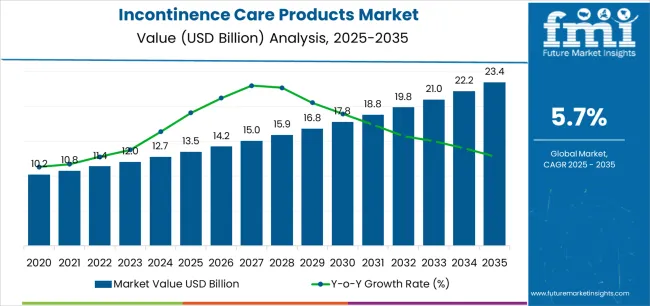
The market is segmented by Product, Gender, Usage, and Distribution Channel and region. By Product, the market is divided into Absorbents, Non-Absorbents, and Stimulation Devices. In terms of Gender, the market is classified into Female and Male. Based on Usage, the market is segmented into Disposable and Reusable. By Distribution Channel, the market is divided into Online Channels, Institutional Sales, and Retail Stores. Regionally, the market is classified into North America, Latin America, Western Europe, Eastern Europe, Balkan & Baltic Countries, Russia & Belarus, Central Asia, East Asia, South Asia & Pacific, and the Middle East & Africa.
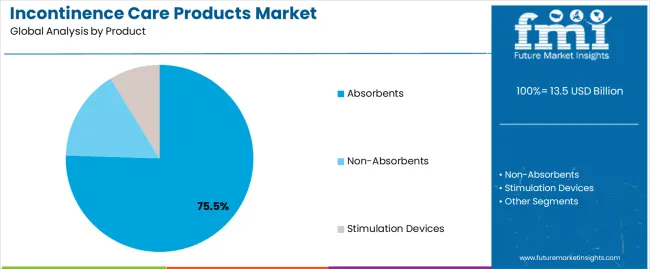
The absorbents segment dominates the product category, holding approximately 75.50% share in the incontinence care products market. This leadership is attributed to their wide application across adult diapers, pads, and underpads, offering effective moisture retention and odor control.
The segment benefits from advancements in superabsorbent polymers and breathable materials that enhance comfort and protection. Widespread use in hospitals, nursing homes, and home care settings has driven demand.
Increasing product diversification tailored to activity level, age, and gender has further strengthened market share. With growing preference for disposable hygiene solutions and continuous innovation in absorbent performance, this segment is expected to sustain its dominance..
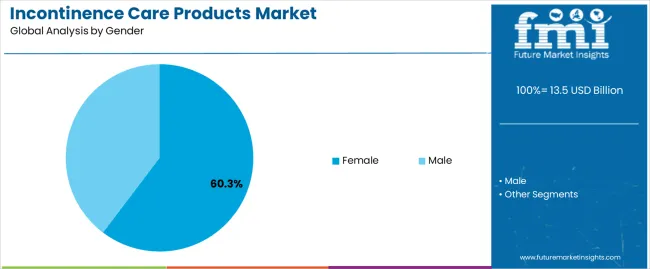
The female segment accounts for approximately 60.30% share in the gender category, reflecting higher prevalence rates of urinary incontinence among women, particularly post-childbirth and during menopause. Market growth is supported by increased awareness, product availability, and targeted marketing campaigns addressing female-specific needs.
Manufacturers are designing anatomically contoured and discreet products offering enhanced comfort and absorption efficiency. Rising healthcare access and the normalization of incontinence product use have further accelerated adoption.
With continuous innovations and an expanding aging female population, this segment is projected to maintain its leading position..
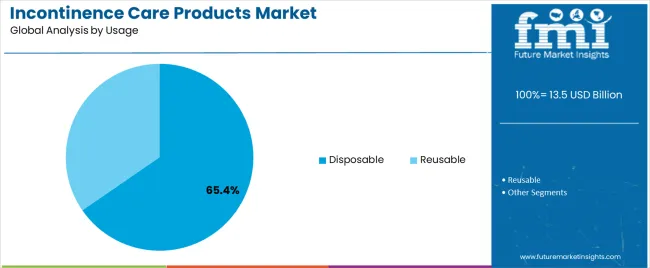
The disposable segment holds approximately 65.40% share in the usage category, driven by its convenience, hygiene, and ease of disposal compared to reusable alternatives. Growing adoption in healthcare facilities and among home users has reinforced market dominance.
Product innovations offering improved absorbency, odor neutralization, and skin protection have enhanced user satisfaction. Increasing preference for single-use items, particularly in hospital and long-term care settings, continues to fuel demand.
With manufacturers emphasizing sustainable materials to address environmental concerns, the disposable segment is expected to sustain robust growth throughout the forecast period..
The scope for global incontinence care products market insights expanded at a 7.7% CAGR between 2020 and 2025. The market is anticipated to develop at a CAGR of 6% over the forecast period from 2025 to 2035.
| Historical CAGR from 2020 to 2025 | 7.7% |
|---|---|
| Forecast CAGR from 2025 to 2035 | 6% |
Between 2020 and 2025, the global market experienced robust growth, expanding at a CAGR of 7.7%. This period was marked by significant factors such as increasing awareness about personal hygiene, technological advancements in product design, and a rising aging population.
These trends LED to greater acceptance and usage of incontinence care products, driving market expansion.
From 2025 to 2035, the market is projected to grow, albeit slightly slower, with a forecasted CAGR of 6%. Factors contributing to this growth include sustained demand from aging populations, ongoing innovation in product development, and introducing eco-friendly and sustainable options.
Factors such as market saturation in certain regions and economic fluctuations may moderate the growth rate compared to the previous period. The market is expected to maintain a positive trajectory, presenting opportunities for companies to capitalize on evolving consumer needs and preferences.
| Attributes | Details |
|---|---|
| Opportunities |
|
The table highlights the CAGRs across five key countries, the United States, Japan, China, the United Kingdom, and South Korea. South Korea stands out as a dynamic and rapidly advancing market, expected to achieve a noteworthy 7.5% CAGR by 2035.
Renowned for its dedication to innovation, the country plays a pivotal role across diverse industries, demonstrating a flourishing economic environment characterized by ongoing advancements.
| Countries | CAGRs from 2025 to 2035 |
|---|---|
| The United States | 6.2% |
| Japan | 7.2% |
| China | 6.6% |
| The United Kingdom | 7% |
| South Korea | 7.5% |
In the United States, the widespread usage of incontinence care products can be attributed to several factors. Firstly, the aging population drives significant demand, as older individuals are more prone to bladder and bowel control issues.
A high level of awareness about personal hygiene and healthcare leads to greater acceptance and usage of incontinence care products. The United States also boasts a well-established healthcare infrastructure, facilitating access to these products for those in need.
In Japan, the adoption of incontinence care products is also influenced by its aging population. Japan has one of the highest proportions of elderly citizens globally, contributing to a substantial market for these products.
A cultural emphasis on hygiene and cleanliness in Japan further boosts the demand for such products. The advanced technological landscape also supports innovation in product design, enhancing its effectiveness and appeal.
The increasing prevalence of lifestyle-related diseases and a growing healthcare awareness have LED to a rising demand for incontinence care products in China.
The aging population and improving healthcare infrastructure contribute to this trend. Additionally, as disposable incomes rise, more individuals can afford these products, further driving market growth.
The United Kingdom exhibits a trend similar to that of other developed countries, with an aging population and increasing awareness about healthcare. The availability of a wide range of incontinence care products and government support for healthcare services contributes to their widespread usage in the United Kingdom.
In South Korea, rapid economic development and a focus on innovation have contributed to adopting incontinence care products. The aging population and a culture that values health and hygiene drive demand for these products.
Advanced healthcare systems and technological prowess support the development of high-quality and effective incontinence care solutions, fueling market growth.
The table below provides an overview of the incontinence care products landscape on the basis of product and usage. Absorbents are projected to lead the product market at a 5.8% CAGR by 2035, while reusable in the usage category is likely to expand at a CAGR of 5.5% by 2035.
Absorbents are projected to lead the product market due to their convenience and effectiveness in managing urinary or fecal incontinence. Reusable incontinence products lead in the usage category primarily because of their cost-effectiveness and environmental sustainability.
| Category | CAGRs from 2025 to 2035 |
|---|---|
| Absorbents | 5.8% |
| Reusable | 5.5% |
Absorbent products, encompassing items like adult diapers, pads, and protective underwear, are anticipated to dominate the product market. They will exhibit a steady growth trajectory with a projected CAGR of 5.8% by 2035.
The projection reflects the enduring demand for convenient and effective solutions to manage urinary or fecal incontinence, particularly among aging populations and individuals with medical conditions.
By usage category, reusable incontinence products are expected to witness notable expansion, forecasted to achieve a CAGR of 5.5% by 2035. Reusable products such as washable adult diapers or cloth pads offer cost-effective and environmentally friendly alternatives to their disposable counterparts.
The growth trajectory signifies a growing preference among consumers for sustainable options, driven by environmental concerns and a desire for long-term cost savings.
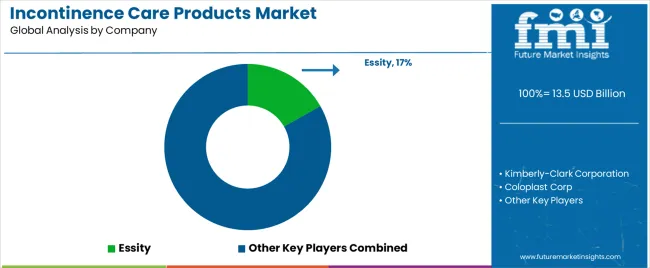
The competitive landscape of the incontinence care products market is marked by the presence of several key players vying for market share. Established brands and emerging entrants engage in strategic initiatives to gain a competitive edge.
Product innovation remains a focal point, with companies continually refining and expanding their product portfolios to address evolving consumer preferences.
Leading companies often emphasize technological advancements, introducing products with enhanced features for improved efficacy, comfort, and user experience. Additionally, sustainability has become a prominent aspect of competition, with companies investing in eco-friendly options to cater to environmentally-conscious consumers.
Strategic collaborations and partnerships with healthcare institutions, retailers, and e-commerce platforms are common strategies to expand market reach. Moreover, marketing efforts include educational campaigns to raise awareness about incontinence issues and the importance of relevant products.
Price competitiveness is a factor, especially in regions with cost-sensitive consumers, influencing purchasing decisions. Regulatory compliance and adherence to quality standards are crucial elements for building consumer trust and maintaining a competitive position.
Key Market Developments
| Attributes | Details |
|---|---|
| Estimated Market Size in 2025 | USD 12.7 billion |
| Projected Market Valuation in 2035 | USD 22.9 billion |
| CAGR Share from 2025 to 2035 | 6% |
| Forecast Period | 2025 to 2035 |
| Historical Data Available for | 2020 to 2025 |
| Market Analysis | Value in USD billion |
| Key Regions Covered | North America; Latin America; Western Europe; Eastern Europe; South Asia and Pacific; East Asia; Middle East and Africa |
| Key Market Segments Covered | Product, Gender, Usage, Distribution Channel, Region |
| Key Countries Profiled | The United States, Canada, Brazil, Mexico, Germany, United Kingdom, France, Spain, Italy, Poland, Russia, Czech Republic, Romania, India, Bangladesh, Australia, New Zealand, China, Japan, South Korea, GCC Countries, South Africa, Israel |
| Key Companies Profiled | Essity; Kimberly-Clark Corporation; Coloplast Corp; Procter & Gamble; Ontex; PAUL HARTMANN AG; Domtar Corporation; ConvaTec Inc.; Wellspect HealthCare (Dentsply Sirona); Hollister Incorporated |
The global incontinence care products market is estimated to be valued at USD 13.5 billion in 2025.
The market size for the incontinence care products market is projected to reach USD 23.4 billion by 2035.
The incontinence care products market is expected to grow at a 5.7% CAGR between 2025 and 2035.
The key product types in incontinence care products market are absorbents, non-absorbents, _catheters, _slings, _drainage bags, stimulation devices, _underwear & briefs, _drip collectors & bed protectors and _pads & guards.
In terms of gender, female segment to command 60.3% share in the incontinence care products market in 2025.






Our Research Products

The "Full Research Suite" delivers actionable market intel, deep dives on markets or technologies, so clients act faster, cut risk, and unlock growth.

The Leaderboard benchmarks and ranks top vendors, classifying them as Established Leaders, Leading Challengers, or Disruptors & Challengers.

Locates where complements amplify value and substitutes erode it, forecasting net impact by horizon

We deliver granular, decision-grade intel: market sizing, 5-year forecasts, pricing, adoption, usage, revenue, and operational KPIs—plus competitor tracking, regulation, and value chains—across 60 countries broadly.

Spot the shifts before they hit your P&L. We track inflection points, adoption curves, pricing moves, and ecosystem plays to show where demand is heading, why it is changing, and what to do next across high-growth markets and disruptive tech

Real-time reads of user behavior. We track shifting priorities, perceptions of today’s and next-gen services, and provider experience, then pace how fast tech moves from trial to adoption, blending buyer, consumer, and channel inputs with social signals (#WhySwitch, #UX).

Partner with our analyst team to build a custom report designed around your business priorities. From analysing market trends to assessing competitors or crafting bespoke datasets, we tailor insights to your needs.
Supplier Intelligence
Discovery & Profiling
Capacity & Footprint
Performance & Risk
Compliance & Governance
Commercial Readiness
Who Supplies Whom
Scorecards & Shortlists
Playbooks & Docs
Category Intelligence
Definition & Scope
Demand & Use Cases
Cost Drivers
Market Structure
Supply Chain Map
Trade & Policy
Operating Norms
Deliverables
Buyer Intelligence
Account Basics
Spend & Scope
Procurement Model
Vendor Requirements
Terms & Policies
Entry Strategy
Pain Points & Triggers
Outputs
Pricing Analysis
Benchmarks
Trends
Should-Cost
Indexation
Landed Cost
Commercial Terms
Deliverables
Brand Analysis
Positioning & Value Prop
Share & Presence
Customer Evidence
Go-to-Market
Digital & Reputation
Compliance & Trust
KPIs & Gaps
Outputs
Full Research Suite comprises of:
Market outlook & trends analysis
Interviews & case studies
Strategic recommendations
Vendor profiles & capabilities analysis
5-year forecasts
8 regions and 60+ country-level data splits
Market segment data splits
12 months of continuous data updates
DELIVERED AS:
PDF EXCEL ONLINE
Incontinence Skincare Products Market Analysis by Product Type, Price, End-User, Sales Channel and Region 2025 to 2035
Suncare Products Market Size and Share Forecast Outlook 2025 to 2035
Skincare Products Market Size and Share Forecast Outlook 2025 to 2035
Sun Care Products Market Analysis – Growth, Applications & Outlook 2025–2035
Car Care Products Market Trends - Growth, Demand & Analysis 2025 to 2035
Nail Care Products Market Growth, Trends and Forecast from 2025 to 2035
Facial Care Products Market Size and Share Forecast Outlook 2025 to 2035
Dental Care Products Market Size and Share Forecast Outlook 2025 to 2035
Personal Care Products Filling System Market Size and Share Forecast Outlook 2025 to 2035
The Dementia Care Products Market is segmented by Memory Exercise & Activity Products, Daily Reminder Products and Dining Aids from 2025 to 2035
Men’s Skincare Products Market Size, Growth, and Forecast for 2025 to 2035
Pregnancy Care Products Market Analysis - Size, Share, and Forecast Outlook 2025 to 2035
Adult Incontinence Products Market
Post Shave Care Products Market Size and Share Forecast Outlook 2025 to 2035
Baby Teeth Care Products Market Size and Share Forecast Outlook 2025 to 2035
Europe Pet Care Products Market Growth, Trends and Forecast from 2025 to 2035
Reusable Incontinence Products Market Analysis - Size, Share & Forecast 2025 to 2035
A Detailed Global Analysis of Brand Share for the Reusable Incontinence Products Market
Buffering Skincare Products Market Analysis - Size and Share Forecast Outlook 2025 to 2035
Baby Personal Care Products Market Analysis - Size & Growth 2025 to 2035

Thank you!
You will receive an email from our Business Development Manager. Please be sure to check your SPAM/JUNK folder too.
Chat With
MaRIA